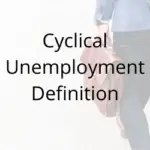Expansionary Fiscal Policy: Definition, Examples & Effects
What is Expansionary Fiscal Policy
Expansionary fiscal policy is the use of government income (taxes) and spending to boost demand. This is done by expanding the amount it spends and reducing the amount it taxes. This is so that it creates more jobs through expenditure, plus gives consumers greater spending power through lower taxes.
On its own, fiscal policy is the collection and expenditure of revenue by government. In other words, fiscal policy refers to how government collects money through taxes, and what it spends money on, i.e. public defence or welfare payments.
Now, expansionary fiscal policy refers to a policy that seeks to grow the economy through fiscal stimulus. Governments do so by using two main methods. The first is lower taxation, and the second is an increase in government spending – which it can do in a number of ways.
Governments use expansionary fiscal policy to stimulate aggregate demand in order to prevent an economic recession and stimulate the wider economy. By lowering taxes, it gives consumers more money to spend. And by increasing expenditure, it can create jobs and improve economic efficiencies.
Key Points
- Expansionary fiscal policy is the use of taxes or government spending to boost aggregate demand.
- Although expansionary fiscal policy is often popular (think lower taxes) – it can have some serious long term effects such as inflation or long-term economic stagnation.
- There are two types of expansionary fiscal policy – taxation and government spending.
Expansionary Fiscal Policy Examples
Governments use two types of expansionary fiscal policy – lower taxation, and increased government spending. Within these, there are several methods and techniques that are used to expand the economy in different ways. For instance, the government could decrease sales taxes to encourage spending – or, it could reduce income tax to potentially encourage saving.
Taxation
If you can think of a tax, then it is part of fiscal policy. Expansionary fiscal policy simply looks to reduce taxation. So this could be lower sales taxes, lower income taxes, or lower inheritance taxes – even including indirect taxes such as tariffs.

Governments can lower different taxes, with varying effects. For instance, lowering income tax by 10 percent would provide a significant boost to consumers net income. The downside is that there would be a massive budget deficit – meaning more borrowing and debt.
However, this may also be accompanied by a contractionary policy on the spending side. For instance, governments may also look to reduce spending at the same time as expanding through lower taxes. That way, the negative effects are partially offset – so debt doesn’t increase.
With that said, let us now look at the five main areas where Governments can reduce taxes and undertake expansionary fiscal policy:
1. Income tax
Gives more income into taxpayers’ pockets but largely benefits the working population – so is largely ineffective for those who don’t work such as pensioners. Nevertheless, the vast majority of the population would benefit, thereby providing a boost to their disposable income. This will provide a boost to aggregate demand, but its extent will depend on the countries marginal propensity to consume. With that said, the income tax is the largest revenue source, so any decrease would significantly impact on the budget deficit.
2. Property tax
An insignificant tax in comparison to others – decreasing it would largely benefit wealthy landowners. Unlikely to benefit the wider economy as successfully as some other tools. The benefits will largely fall to richer households which have a higher marginal propensity to save – thereby failing to boost aggregate demand in the short-term.
3. Consumption tax
Another costly fiscal tool that would increase the budget deficit. Would help the poor the most as they spend the highest proportion of their income. This is most likely to stimulate the economy if a decline in taxes is brought through into lower prices.
4. Tariffs
More political than the other taxes – high tariffs are likely to be reciprocated abroad. By lowering tariffs, it encourages other nations to lower theirs too. In turn, it makes goods coming in cheaper and can create a new market for domestic suppliers. In terms of cost-effectiveness, this is probably the best approach.
5. Corporation tax
Another politically sensitive area, as cuts are seen as a gift to the rich. This is perhaps an area where the cost of cuts can vary. For instance, we may see an increase in revenues from cuts; as we did in the UK following the cuts in 2011, 2012, and 2013. They can be effective if businesses respond with higher levels of investment in the economy.
Government Spending
Expansionary fiscal policy is often associated with greater government spending. In fact, many Keynesian economists favour it over lower levels of taxation. The argument is that lower taxes give consumers more money, but doesn’t mean they will spend it. However, greater government spending is guaranteed to stimulate aggregate demand as it employs people and puts money into the hands of those who have none or little.

Politically speaking, there are advantages to this approach. Whilst dropping taxes provides political capital in the short-run, it presents difficulties in increasing it again.
Let us now look at the main areas where governments increase spending and its effects:
1. Infrastructure
Most infrastructure projects will create some level of employment, particularly in construction – which creates jobs and provides those employees with a salary. In turn, they have more money to spend in the wider economy. If the government spends wisely, it could create greater efficiencies to the wider economy, but what effect does this have?
As with all government spending, it can have a detrimental impact on the economy in the long-term as it squeezes out private investment. For instance, infrastructure investment particularly takes away employment from the private sector. For instance, construction workers who would be undergoing private infrastructure projects are now undertaking public projects. In turn, this additional competition makes private infrastructure projects more expensive.
2. Welfare
One of the biggest government expenditures. In recessionary periods, this naturally increases as more unemployment benefits are due. So there is an argument that we can consider this a naturally occurring expansionary policy. With that said, millions will benefit from such a safety net, especially those with disabilities who may be granted a better life if additional funds are provided.
With that said, greater welfare spending has its drawbacks. For instance, there is the argument that it creates a greater reliance on the system, meaning people get stuck on social security. In some instances, it is more profitable to stay unemployed than take a low-skilled job. At the same time, it benefits businesses who can pay workers less than they would under normal conditions.
3. Education
The benefits of spending more on education are not necessarily quantifiable. We may generally assume more spending means better results, but this is not necessarily the case. Even though higher levels of spending on education is still money that’s injected into the economy, the drawback is that we don’t really know if the investment has paid off. The only barometer is test results, but they are not necessarily a true reflection on value.
4. Health
Another area which is not necessarily intended to boost the economy but can do so indirectly. More investment in healthcare can create spillover effects into other areas of the economy. For instance, the NHS in the UK is one of the biggest employers in the world, let alone the country.
Effects of Expansionary Fiscal Policy
1. Inflation
Expansionary fiscal policy provides a strain on government finances. This is because increases in public spending are likely to increase the budget deficit. In turn, governments will see to increase spending by increasing its level of debt in the hope revenues will increase in the long-term.
At the same time, expansionary fiscal policy seeks to reduce taxes which provides greater income to households. Those some households will create additional demand in the wider economy. This can then send a signal to businesses which encourages them to raise prices as a result of the increase in demand.
The combination of higher consumer and government spending mean additional levels of money circulating in the economy. The result is therefore likely to lead to higher levels of inflation.
2. Increase in Government Debt
Expansionary fiscal policy means that governments spend more and tax less. Inevitably, this leads to higher levels of debt. It may be the case that the economy expands in such a way that income increases substationally enough to cover the extra expenditures. However, this is not always the case.
If an economy is in a stagnant economic recession, then expansionary fiscal policy may be what is needed to help lift it out. Yet this is a complex area which depends on various factors depending on the structure and health of the economy. What is evident though is that in the short-term, the expansionary fiscal policy will need to be paid for by debt.
3. Long-term Economic Stagnation
One of the unseen effects of expansionary fiscal policy is the long-term effects. This is because the consequences are not immediate. When governments use expansionary fiscal policy to boost the economy, it can have some positive effects in the short term. Unemployment may decline and consumer spending increases.
The issue lies in the fact that governments generally see huge increases in debt. It’s spending more and taxing less, which has a dramatic impact on its revenue. In the short-term, governments can fund such on debt. However, it needs to pay those debts of in the long-term.
One example of this effect of expansionary fiscal policy can be seen in Greece. The nation was spending significant sums on expanding the economy, but did little in the way of bringing money in. The consequence of such was the signficant economic recession in 2011 and subsequent need for austerity. Over the last decade, the Greek people have suffered from higher taxes and poor public services as governments have been forced to make cuts.
4. Crowding Out
When government use expansionary fiscal policy, it borrows money from the private sector. Businesses could use that same money to expand production and build a new factory. Instead, the competition for credit becomes more difficult and with additional demand from government, it can actually become more expensive for businesses to borrow.
5. Higher Interest Rates
Under expansionary fiscal policy, governemnts borrow significant sums of money to help stimulate the economy. However, the more it borrows, the fewer investors there are. This means that in order to attract a wider pool of investors, it must offer higher rates of interest.
As government bonds and gilts are considered safe investments – the higher interest rates have a subsequent effect in the wider market. For example, the government may offer a rate of 4 percent on its bonds. This would mean that businesses seeking credit would in all likelihood have to offer a higher rate such as 5 percent to attract investors.
Objectives of Expansionary Fiscal Policy
The aims and objectives of expansionary fiscal policy are slightly different from that of other types. Let us look at the below:
1. Boost Aggregate Demand
Particularly during recessionary periods, governments tend to use expansionary fiscal policy. This is because recessionary periods are associated with declining consumer demand. In addition, businesses are investing less and employing fewer people.
This is also known as contractionary period in the business cycle. it is characterised by falling demand, yet it can continue in a continuous downward spiral. With consumer demand falling, businesses invest less and employ fewer people. So it can turn into a deep downward cycle.
The aim of government, therefore, is to ‘stop the rot’ so to speak. By investing in the economy, it can help prop it up and create artificial demand. In turn, this sends a signal to businesses who will start to invest again, stimulated by new demand from the government.
2. Stimulate Employment
Most nations have a level of unemployment that is in excess of ‘full employment’. So there is always room for improvement. Consequently, most governments aim to reach this fabled target. Full employment is the aim and creating government jobs goes a way to meeting such.
The aim of expansionary fiscal can be considered in two ways. First of all, it can directly stimulate employment through government work programs or other forms of public employment. Second of all, it can do it indirectly by lowering taxes. This would provide more money into consumers’ pockets, but is not guaranteed to stimulate employment if consumers save rather than spend.
3. Increase Investment
During economic downturns, business investment naturally declines. This is driven in part by negative sentiment and declining consumer demand. At the same time, lower investment can impact on job creation as well. So governments target these objectives simultaneously.
By investing in local infrastructure, it not only creates jobs in the area but also encourages businesses to locate and invest there. For instance, new schools and better transport can attract both businesses and consumers alike.
Related Topics
FAQs on Expansionary Fiscal Policy
An example of expansionary fiscal policy could be an increase in welfare spending. However, it is only considered expansionary if the government doesn’t bring in the same amount through taxes. In other words, it’s spending more than it’s bringing in. So any other increase in government spending could also be considered expansionary.
The simple answer is that it depends. If the government spends trillions, then Inflation is likely. Yet, it will also depend on HOW it spends the money and WHERE it goes to. For instance, increased welfare payments are more likely to translate into inflation than new infrastructure projects. As welfare payments go to the poorer in society, they generally spend a higher proportion of their income; meaning the payments will flow into the wider economy, causing inflation.
Expansionary fiscal policy is categorized into two areas. First of all, government spending, and second of all taxation.
About Paul
Paul Boyce is an economics editor with over 10 years experience in the industry. Currently working as a consultant within the financial services sector, Paul is the CEO and chief editor of BoyceWire. He has written publications for FEE, the Mises Institute, and many others.

Further Reading
 Cyclical Unemployment: (What it is, 3 Causes & Example) - Cyclical unemployment is where unemployment trends in line with the business cycle.
Cyclical Unemployment: (What it is, 3 Causes & Example) - Cyclical unemployment is where unemployment trends in line with the business cycle.  Bill of Sale - A bill of sale is a legal document that serves as proof of the transfer of ownership of an item…
Bill of Sale - A bill of sale is a legal document that serves as proof of the transfer of ownership of an item…  Empirical Rule - The empirical rule, also known as the 68-95-99.7 rule, states that in a normal distribution, approximately 68% of the data…
Empirical Rule - The empirical rule, also known as the 68-95-99.7 rule, states that in a normal distribution, approximately 68% of the data… 
